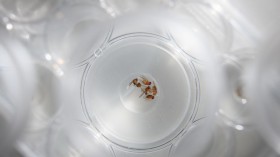Two mammal-like reptiles were confirmed to be the species that led to the rise of the mammals. These two ancient reptiles belong to the group of cynodonts, according to journal PLOS ONE. These confirmations are formed after studying two fossils that are found in the museums in Brazil.
"These new fossils help [us] understand in more detail the evolution of pre-mammalian forms that gave rise to the group of mammals, in which we humans (Homo sapiens) are included," the study's lead author, Agustín Martinelli, a paleontologist at the Federal University of Rio Grande do Sul in Brazil, told Live Science in an email.
One of the newfound cynodont species is part of the extinct group of carnivorous cynodont called Probainognathidae. Based on the two skulls and two jaws found in a rock in Santa Cruz del Sol by paleontologist L.I. Price decades ago, the small animal was estimated to be 12 inches in length and has unusually large proturding upper-canine teeth.
The specimen has been housed at the Museum of Earth Sciences in Rio de Janeiro in Brazil since 1946. Researchers said that this creature is "different enough" that it now has its own genus and species called Bonacynodon schultzi, in honor of José Bonaparte from Argentina and Cesar Schultz from Brazil, the paleontologists who studied Triassix fossils of South America.
The second specimen, a jaw with teeth, made up the other newfound cynodony species called Santacruzgnathus abdalai. The name came from Fernando Abdala, an Argentinian paleontologist who studies South American and African cynodonts. This animal only measures six inches in length and is about half the size o f B. schultzi. The shape and dentition of S. abdalai's teeth are "reminiscent of those present in early mammals," Martinelli said.
In a Live Science report, it said that the cynodonts were split into two groups: the cynognathians, which were mainly plant-eaters, and the probainognathians, which were mostly flesh-eaters. After the devastation of the Permian era, ancient reptiles -- which are the early cynondonts -- appeared. These weird-looking animals were smaller than a size of a loaf bread and resemble scaly rats. They roamed Brazil 250 million years ago and even predates the dinosaurs.
© 2024 NatureWorldNews.com All rights reserved. Do not reproduce without permission.





